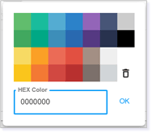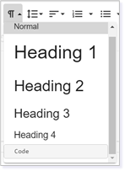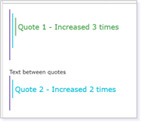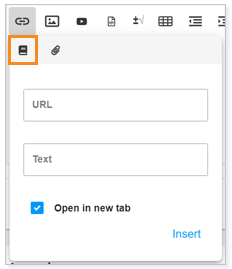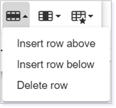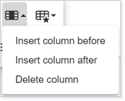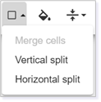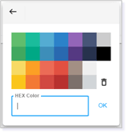This article outlines and details the different Buzz Text Editor options available to users.
ARTICLE QUICK LINKS
This article includes the following primary sections. Use these links to navigate directly to the section.
- Buzz Text Editors
- Editor Options
- Using Hyperlink
- Using the Draw Feature
- Insert Image
- Insert YouTube Video
- Insert Equation
- Embed Content
- Table Options
BUZZ TEXT EDITORS
Within Buzz, there are many places where users can insert text via the Text Editor. These include the Landing Page of a course, an Assessment, and Announcements as well as other places. Each editor looks slightly different, but many of the buttons on each editor are the same.
Announcements

Messages Through Clipboard

Assessment

Click here to return to the Article Quick Links.
EDITOR OPTIONS
Some Text Editors currently have limited options. Below, you can see each option available in the different editors and how it can be used. If an option is not available in all Text Editors, you will see Optional within the description.
| Font |  |
This option can be selected to change the font style.
Optional: Not available in Grading Feedback text editor |
| Font Size |
This option can be selected to change the size of the font.
Optional: Not available in Grading Feedback text editor |
|
| Text Color |  |
This option can be selected to change the color of the font. You can also enter a HEX color for a specific color.
|
| Background Color |  |
This option can be selected to change the background color of the font. This feature is similar to highlighting text. You can also enter a HEX color for a specific color.
|
| Bold |  |
This option can be selected to bold the text. |
| Italic |  |
This option can be selected to italicize the text. |
| Underline |  |
This option can be selected to underline the text. |
| Strikethrough |
|
This option can be selected to strike through the text. Optional: Only available in Assessment text editor |
| Subscript |
|
This option can be selected to place a subscript in the text. Pressing the button again will allow you to add normal text. Optional: Only available in Assessment text editor |
| Superscript |  |
This option can be selected to place a superscript in the text. Pressing the button again will allow you to add normal text. Optional: Only available in Assessment text editor |
| Bulleted List |  |
This option can be selected to create a bulleted list in your text. Optional: Not available in Grading Feedback text editor |
| Numbered List |  |
This option can be selected to create a numbered list in your text. Optional: Not available in Grading Feedback text editor |
| Indent |  |
This option can be selected to indent the line of text. TIP: Pressing the button multiple times will indent the line multiple times. Optional: Only available for Announcements and Assessment text editors |
| Reduce Indent |  |
This option can be selected to reduce the indent for a line of text. TIP: Pressing the button multiple times will reduce the indent multiple times. Optional: Only available for Announcements and Assessment text editors |
| Align Left | 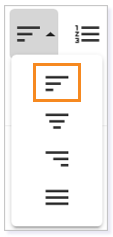 |
This option can be selected to align text to the left. Optional: Not available in Grading Feedback text editor |
| Center | 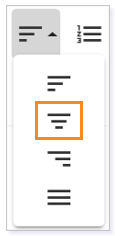 |
This option can be selected to center the line of text. Optional: Not available in Grading Feedback text editor |
| Align Right | 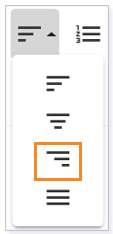 |
This option can be selected to align text to the right. Optional: Not available in Grading Feedback text editor |
| Justify | 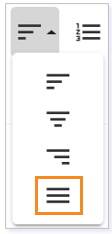 |
This option can be selected to give the text a straight edge on both the left and right sides. Optional: Not available in Grading Feedback text editor |
| Paragraph Format |  |
Selecting this option will allow you to choose a preset paragraph format for the selected text or line.
Optional: Only available in Assessment text editor |
| Quote |  |
Selecting the Quote option will allow you to format the selected line as a quote.
Clicking Increase will increase the level of the quote. Clicking Decrease will remove the current level of the quote.
Optional: Only available in Assessment text editor |
| Undo |  |
This option can be selected to undo the last change that was made. Optional: Only available for Announcements and Assessment text editors |
| Redo |
This option can be selected to redo a change that was undone. Optional: Only available for Announcements and Assessment text editors |
|
| Select All |
Selecting this option will select all inserted text in the text box. Optional: Only available in Assessment text editor |
|
| Clear Formatting |
Selecting this option will clear all formatting for the selected text. Optional: Only available in Assessment text editor |
|
| Insert Horizontal Line |  |
Selecting this option will place a horizontal line in the text box. Optional: Only available in Assessment text editor |
| Code View |  |
This option can be selected to display the HTML code view of the text. It also allows you to work in the code view. Optional: Only available in Assessment text editor |
| Full Screen |  |
This option can be selected to make the text editor full screen. It can be helpful to view the screen as students will see it and to remove distractions. Optional: Not available in Message through Clipboard text editor |
| Hyperlink |  |
This option allows you to link to a website, course content, or course resources. To learn more about how to use the hyperlink option, review the Using Hyperlink section of this article. Optional: Not available in Message through Clipboard text editor |
| Draw |  |
This option allows you to draw an image in the text editor. To learn more about how to use the Draw feature, review the Using the Draw Feature section of this article. Optional: Not available in Message through Clipboard text editor |
| Insert Image |  |
Use this option to insert images. To learn more about how to insert images, review the Insert Image section of this article. Optional: Not available in Message through Clipboard text editor |
| Insert YouTube Video |  |
Use this option to insert YouTube videos. To learn more about how to insert YouTube videos, review the Insert YouTube Video section of this article. Optional: Only available in Announcements and Assessment text editors |
| Insert Equation |  |
Use this option to create mathematical equations. To learn more about how to insert equations, review the Insert Equation section of this article. Optional: Not available in Message through Clipboard text editor |
| Embed Content |  |
Use this option to insert content with an embed code. To learn more about how to embed content, review the Embed Content section of this article. Optional: Only available in Announcements and Assessment text editors |
| Table |  |
Use this option to create, edit, and format tables. To learn more about Table features, visit the Table Options section of this article. |
USING HYPERLINK
Selecting the Hyperlink icon will open an Insert Link pop-up menu.
URL Link
In the URL field, you can paste a link to an outside website.
Selecting the checkbox beside Open in new tab will allow the link to open in a new browser tab when it is clicked.
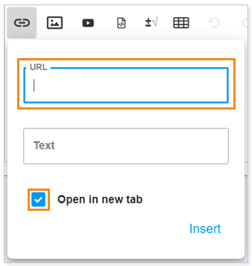
If you selected text to hyperlink, such as “click here,” the text will show in the Text box field.
If you did not select text to hyperlink, you can type the text in the Text field at the time you are creating your link.
TIP: Don’t forget to paste the entire URL, including the http:// URL prefix.
Course Link
IMPORTANT: Course Link may not not always be available when you see the Hyperlink option.
The Course Link tab will let you link to a place in the course.
You can navigate to the folder or individual activities and select the course item to which you want to link.
NOTE: The ability to link to a folder vs. an activity may vary depending on the text editor.
Text will fill automatically, depending on your selected item; however, this text can be changed by typing different words in the Text field.
Select the Open in new window checkbox if you prefer your folder or activity to open in a new window when clicked.
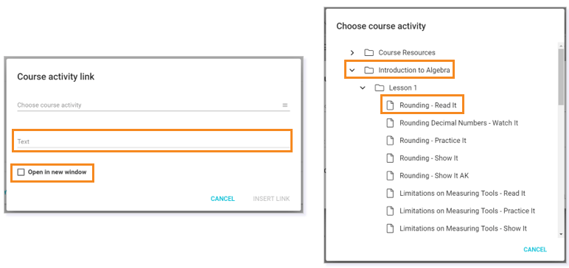
Course Resource
IMPORTANT: Course Resource may not always be available when you see the Hyperlink option.
The Course Resource tab will allow you to link to a document you have uploaded into the Course Resources, such as a PDF.

Click Choose a course resource to choose from the items that have already been uploaded as a course resource.
Click the upload cloud icon on the right to upload a document from your computer.

Once you determine which resource to link, click INSERT LINK.

Click here to return to the Article Quick Links.
USING THE DRAW FEATURE
In the text editor, choose the Draw option.
A pop-up window will open with an area to draw and several options to edit your drawing.

When you are finished drawing, don’t forget to SAVE CHANGES.

Clicking the Draw option will open an area where you can draw in the editor.
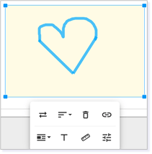
You will find a menu of options when you click in the draw area.

Draw Feature Edit Options
| Replace |  |
By clicking the replace icon, you can replace the drawing with an image. TIP: See Insert Image for more details on how to use images in the text editor. |
| Align |  |
You can left align, center, or right align the drawing. |
| Remove |  |
You can remove the drawing by clicking on the trashcan icon. |
| Link |  |
By adding a link, you can hyperlink a URL to the drawing. Once you add a hyperlink, you will receive additional menu options. Open Link, Edit Link, and Unlink will be available for the link.
|
| Display |  |
Clicking the Display icon will provide an additional menu where you can choose to have the image inline with the text, around it, or you can break text with the image.
|
| Alternative Text |  |
You can insert alternative text to describe the image by clicking this icon. |
| Change Size |  |
You can change the size of the image by clicking on the ruler icon. A pop-up menu will appear where you can choose the pixel width and height of the drawing.
|
| Advanced Edit |  |
Clicking this icon will take you to the advanced menu that was available upon opening the drawing option. TIP: See Using the Draw Feature to learn more about these menu items. |
INSERT IMAGE
Inserting an Image
Clicking the icon will open a pop-up window to insert an image.
Click or drag the image you want to insert.
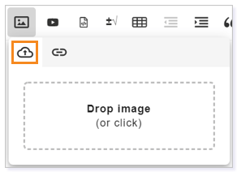
Editing an Inserted Image
Once the image has been inserted, you can click on the image to Replace, Align, Remove, Insert Link, change Display options, add a description with Alternative Text, and Change Size.
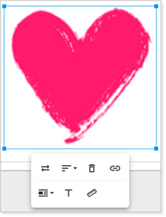
Click here to return to the Article Quick Links.
INSERT YOUTUBE VIDEO
To insert a YouTube video, click the icon and a pop-up menu will appear. Within this menu, you can paste the link to the YouTube video.
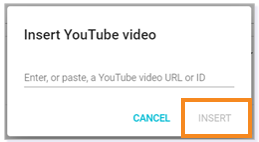
Click INSERT to insert the YouTube video into your text.
TIP: No additional videos will show with the YouTube video you link to, but links embedded in the video will be available to students.
INSERT EQUATION
Clicking the Insert Equation icon will open the Edit equation pop-up menu.

You can type the equation in the top field. The bottom field will display a preview of the equation.
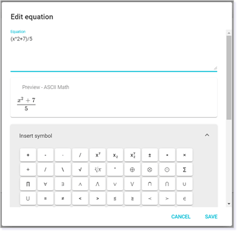
To make building your equation easier, you can also click Insert symbol.
The Insert symbol options can be expanded and minimized as needed.
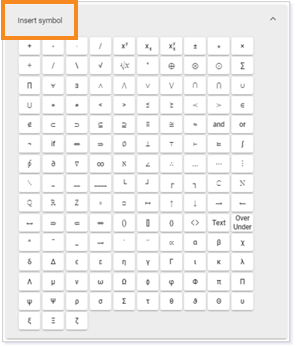
Commonly Used Symbols
 |
Exponent: The base of an exponential expression is the larger number that is getting the exponent. This is represented by x in the icon. The exponent, or power, is the small number that is raised up and to the right of the base. This is represented by the y in the icon. |
 |
Subscript: A type of lettering form where one letter is written lower than the letters around it. The subscript is represented by the z in the icon. |
 |
Square Root: The square root of a number is a value that, when multiplied by itself, gives the number. |
 |
Radical Expression: A radical expression is an expression containing a square root or an nth root. The nth root is represented by the y in the icon. |
 |
Degree: A degree is a measure of temperature or the measure of an angle. |
 |
Fraction: A fraction is part of a whole number. The top number (the numerator) represents how many parts exist. The bottom number (the denominator) represents the number of parts into which the whole is divided. |
 |
Whole Number With a Fraction: This option places a fraction beside a whole number. |
Exponent
The base of an exponential expression is the larger number that is getting the exponent.
The exponent, or power, is the small number that is raised up and to the right of the base.
Start by typing the whole number into the top box in the equation editor.

Next, click Insert symbol.

Select the Exponent button. A carrot will appear next to the whole number you previously typed.

Type the number that you would like to appear as the exponent.

The correct equation will show in the bottom box.

Select SAVE to add it to the exam.

Click here to return to the Commonly Used Symbols.
Subscript
A subscript is a lettering form where one character is written lower than the characters around it.
Start by typing the whole number into the top box in the equation editor.

Next, click Insert symbol.

Select the Subscript button. An underscore will appear next to the whole number you previously typed.

Type the number that you would like to appear as the subscript.

The correct equation will show in the bottom box.

Select SAVE to add it to the exam.

Click here to return to the Commonly Used Symbols.
Square Root
The square root of a number is a value that, when multiplied by itself, gives the number inside the symbol.
Start by clicking Insert symbol.

Next, select the symbol for square root.

Type the appropriate number next to the symbol. If the number is a fraction, place it in parentheses.

The correct equation will show in the bottom box.

Select SAVE to add it to the exam.

Click here to return to the Commonly Used Symbols.
Radical Expression
A radical expression is an expression containing a square root or an nth root.
Start by clicking Insert symbol.

Next, select the symbol for radical expression.

Fill in the index (y) and radicand (x) with the appropriate numbers.

The correct equation will show in the bottom box.

Select SAVE to add it to the exam.

Click here to return to the Commonly Used Symbols.
Degree
A degree is a measure of temperature or the measure of an angle.
Type the whole number in the top box.

Next, click Insert symbol.

Select the Degree button.

The top box will contain the whole number, a carrot, and the @ symbol.

The correct equation will show in the bottom box.

Select SAVE to add it to the exam.

Click here to return to the Commonly Used Symbols.
Fraction
A fraction is part of a whole number. The top number (the numerator) represents how many parts exist. The bottom number (the denominator) represents the number of parts into which the whole is divided.
Start by clicking Insert symbol.

Select the Fraction button.

Place the numerator on the left side and the denominator on the right side.

The correct equation will show in the bottom box.

Select SAVE to add it to the exam.

Click here to return to the Commonly Used Symbols.
Whole Number With a Fraction
This option places a fraction beside a whole number.
Start by clicking Insert symbol.

Select the Whole Number with a Fraction button.

Replace the x with the whole number, the y with the denominator, and the z with the numerator.


The correct equation will show in the bottom box.

Select SAVE to add it to the exam.

Click here to return to the Commonly Used Symbols.
Click here to return to the Article Quick Links.EMBED CONTENT
Click the Embed content button to embed content directly in your text.

You can change the size and position of the content in the Properties section.
The Preview section allows you to preview what you have embedded.
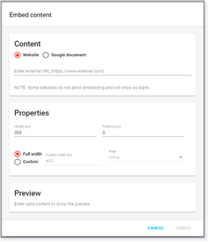
You can embed a website using the first radio button.
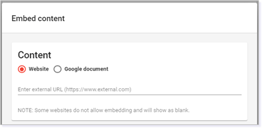
Using the second radio button, you can embed a Google document.

Click here to return to the Article Quick Links.
TABLE OPTIONS
Start by selecting the Table icon.

You will have the option to create a table up to 10 by 10 in size.
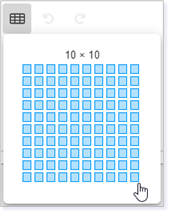
Choose the table’s size and it will appear in the Editor.
Once a table is inserted into the Text Editor, you can click in the cells to type and add your information to the table.

Adjusting Table Formatting
Once you have created the table, click anywhere inside the table for table formatting.
A pop-up menu will appear. You will have the option to create a Table Header, Remove Table, adjust by Row, adjust by Column, adjust Table Style, adjust by Cell, change Cell Background, Vertical Align, and Horizontal Align.

Table Options
| Table Header |  |
Selecting this option will insert a header row on the table. Clicking it again will remove the header row. |
| Remove Table |  |
Selecting this option will delete the table. |
| Row |  |
Selecting this option will open a drop-down menu with options to insert additional rows or delete the current row.
|
| Column |  |
Selecting this option will open a drop-down menu with options to insert additional columns or delete the current column.
|
| Table Style |  |
Selecting the Table Style icon will open a drop-down menu with the option to remove the borders for the table. Selecting this option again will bring the borders back.
|
| Cell |  |
Selecting the Cell icon will open a drop-down menu with the options to merge or split the cell(s) that are selected.
|
| Cell Background |  |
Selecting the Cell Background icon will open a drop-down menu with the option to select a color for the background of the cell.
You can use additional colors by inserting a HEX code in HEX Color field at the bottom of the box. Clicking OK will apply the color you select. |
| Vertical Align |  |
Selecting this option will open a drop-down menu that allows you to align text vertically to the top, middle, or bottom of the cell.
|
| Horizontal Align |  |
Selecting this option will open a drop-down menu that allows you to align text horizontally to the left, center, or right of the cell. You may also justify text within a cell using this option.
|
Click here to return to the Article Quick Links.
Please note, the images that may be found in this resource may not match your screen.
This is a Lincoln Learning Solutions product. Access/features may vary based on client contract.
© 2021 Lincoln Learning Solutions. All rights reserved.




